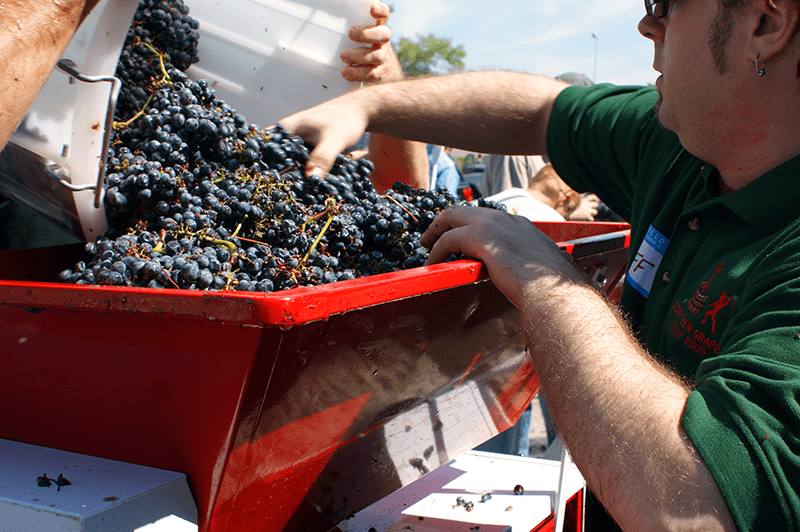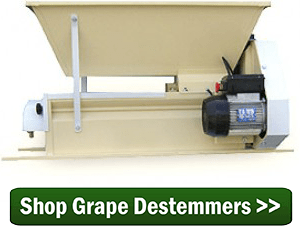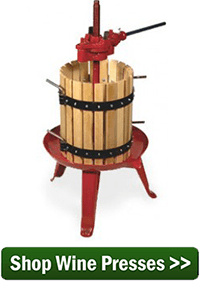 Any of the wine making books you read, will tell you that wine grapes need to be crushed and pressed. The same holds true for the directions that typically come with any wine making recipes, but what does it actually mean to crush and press the wine grapes?
Any of the wine making books you read, will tell you that wine grapes need to be crushed and pressed. The same holds true for the directions that typically come with any wine making recipes, but what does it actually mean to crush and press the wine grapes?
Many beginning winemakers think crushing and pressing to mean the same thing, that the terms are interchangeable, when in fact both mean something very different. To understand just how different you must first know a little bit about the wine making process.
When making wine from grapes it is important to realize that you are not only dealing with the juice from the grapes. You are also dealing with the pulp, the skin, and all the fiber that make up the grape. It is from these organic solids that the grape is able to provide body, color and certain flavor characteristics to the wine. Without them all you have is clear grape juice with very minimal qualities.
This is why when a winery makes a red wine, the skin and pulp are actually in the fermentation along with the grape’s juice. Once the fermentation has almost completed, all the fibrous solids of the grapes are then removed.
But how do these grapes become a soupy mix that is fermentable? Then later, how is the skin and pulp removed? This is where crushing and pressing come into practice.
Crushing Wine Grapes
 Crushing is what’s done before the fermentation. It’s what changes the plump grapes from something you pop into your mouth to something you can slop around in a fermenter.
Crushing is what’s done before the fermentation. It’s what changes the plump grapes from something you pop into your mouth to something you can slop around in a fermenter.
Crushing the grapes is a very straight-forward task. It’s simply a matter of bursting the skins so that all the inner solids can be exposed to the fermentation. Enough free-flow juice will release from the grapes to turn the crushed mix into something liquid we call a wine must.
You can crush the grapes by doing something as archaic as throwing the grapes into a bucket and pounding them with the butt end of a 2×4, or you can be as elaborate as processing them through a grape crusher that was designed specifically for the purpose. A grape crusher is typically a hopper that leads to two rollers that are placed closely together. The wine grapes are crushed by going between the two rollers. Both methods do equally well. It’s more a matter of how many pounds of wine grapes you are needing to crush and how much work you are willing to do.
Pressing Wine Grapes
 Once the wine must has fermented for around 5 to 7 days it is then time to remove all the solids. This is when you’ll see a winery pull out the grape presses and start pressing the wine must. The must is dumped into the pressing basket. Immediately, free-run juice will start flowing from the grape press spout. What’s remaining in the basket is then pressed to extract even more juice.
Once the wine must has fermented for around 5 to 7 days it is then time to remove all the solids. This is when you’ll see a winery pull out the grape presses and start pressing the wine must. The must is dumped into the pressing basket. Immediately, free-run juice will start flowing from the grape press spout. What’s remaining in the basket is then pressed to extract even more juice.
As a home winemaker you do not necessarily need to use a wine press. If you are dealing with a small batch and have only 2 or 3 pounds of pulp, you can press it by hand as best as you can. A fermentation bag can come in handy for this process. Collect the pulp into the bag. Then hang it over a fermenter while you squeeze it. The biggest drawback to this is you will not get nearly as much juice from the pulp as a wine press can.
If you are dealing with a little larger amount, a wine press is almost a necessity. We have affordable grape presses as small as our Table-Top Press. It is ideal when making 10 or 15 gallons of wine.
So, as you can see there is a big difference between crushing and pressing grapes. And, each as an important function in the wine making process.
—————
Ed Kraus is a 3rd generation home brewer/winemaker and has been an owner of E. C. Kraus since 1999. He has been helping individuals make better wine and beer for over 25 years.

To crush small batches I have used the meat grinding attachment on my kitchenaide mixer with the discs removed, leave in the spiral "thingy" and the screw on cap. It worked wonders on muscadines. I did the hand crushing a couple of times and decided that I had to find a better and less painful way.
I’m new at wine making and have read many articles. The articles I’ve read always alluded to crushing and pressing but with no real explanation. The wine kits are became boring and predictable, I have ventured out and begun making country wines and other wild grape wines I now know what equipment I need for these and where I will purchase it.
Thank you
I have been making homemade wine for 4 years now with Muscadines and Scuppernongs. I always hand crushed the grapes, even last year when I had approx. 600 lbs. (froze a lot first then used at my convenience). What I am confused about is when you say “ferment for 5-7 days” then press the grape. Fermenting to me means the must has had the necessary ingredients, including the yeast, to start the fermentation. Is that what you are saying? I have never pressed any grapes but now have a Weston press (50 lb. capacity) to use as a further learning experience soon. My question? Do you really start the hard core fermentation first with crushed grapes, with the pectic enzyme, yeast nutrient, acid blend, yeast etc. etc. and wait 5-7 days and THEN press? I’m confused in this portion of the procedure you are discussing. All my wine has come out fantastic though (so far) so I guess what I would really be missing in the pressing step is getting all the juice one possibly can? Thank you.
Ed,
I’d love to hear you compare and contrast crushing the grapes with a steam juicer especially when using muscadines
I make wine like my grandpa and dad. First get a clean five gallon jug and put in two pounds of white sugar with three fourths gallon of pinched grapes. Using a oak wooden dowel inserted into the jug I mash and mix the two to get thick slurry then add four more pounds of white sugar with one gallon of grapes, repeting the process again, adding 1/8th cup of brown sugar. Then after adding my warm yeast slurry I mix it well with the oak dowel after adding flowing well water that has set over night.
I have used this with grape, cherry, peach, and elderberry for too many years to count, and never had a bad batch. I never remove the grapes till I bottle. I don’t know, it just tastes better that way, especially with flowing well water.
I have been making wine for several years now, sense I do it in my basement I mostly used kits, but all different kinds, Cherry is my favorite I make 9 gallon at a time . I started what I though was going to be a white wine made from welches concentrate but a can of concord got mixed in and it is pink but has a great taste still working , have to rake it a couple of times before bottling it.
Just wanted to say thanks for all the help over the years.
Smooth drinking but not to much!
I make five gallons of muscadine wine each year. Just read you ferment juice with skins then press.
I suppose you have to work with all steralize equipment at this point?
I have your small wodden tabletop press. What is the best method in getting all the juice into the bucket with out making a big mess.
Should I use plasic sheeting to capure slash, or should I just not worry about loosing some juice that does’nt cooperate and get in the bucket?
I guess It seems the ring arround the bottom of the press does a poor job of gettig all the juice into the bucket.
John, yes, you always want to sanitize any equipment used in the wine making process. When using any type of press it is normal to to have a little mess and lose a little juice. Sitting the press over a bucket as you are doing is the best process. Using a plastic sheet is a good idea to cut down on some of the mess and perhaps catch some of the juice that does not make it into the bucket.
I have Found to make a white(or yellowish) wine from Red grapes, is to crush, the immediately Press the Grapes to separate the Skins and most flesh, from the nearly Clear juice. But, Maybe that is Just me.
Soooooo…..add the yeast to crushed grapes, let ferment for a week, then press (is what I am hearing?)
Kipfox, if you are making making wine from red grapes that is correct. This is so you can extract more color from the grapes. If making wine from white grapes you will press the juice prior to fermentation. The article posted below will explain the process in more detail.
When To Press Grapes
http://blog.eckraus.com/when-to-press-grapes-for-wine
Crush AND Press?? I understand that for the Primary you do want the skins broken to allow Yeast, Pectic, etc to work on the entire fruit. For 4 years I have been using my prohibition era 3 gallon Juicy Fruit Press for both. I see no need for another set of equipment.
It is important not to crush open the grape seeds in the process to make wine. (Of course some grapes do not have seeds) White wine stays clear because the skins are kept out of the pressing process. The skins in the process of making red wine are needed to create the color. All grape juice is clear: The skin for red wine is necessary for the red color.
Hello ,for the red wine yes need to fermented 2 to 3 weeks with skins before pressing, but nowadays I saw one winery they steam the grapes right after crushed and after a fews hours pressed the grape and do fermentation without skin . It is possible for red wine ?
I have no experience with this particular process. I’m sure it is possible to do with “red” grapes. The biggest question is: how much color are you getting from the grape with this process? Or, will you end up with a blush wine. There is also the issue of oxidation. Heat would promote the oxidation of the wine. I suspect that they are treating the must with something before heating. For example, raising the acidity to a ridiculous amount before heating to protect it. Then taking the excess acid out after heating through chilling and other methods. My point is that there may be a little more to it than just the steaming, so beware.
I used my press for the first time and experienced two issues and I need some advice please.
1 – Pressing my grapes a lot of juice seemed to get stuck in the press because grape skins clogged the sides.
2 – After pressing I had a lot of plump grapes with no skins.
Any ideas on how to fix this. I am currently making grape juice out of Concords
Tony, are you crushing the grapes before trying to press them? The fact that you mention having plump grapes leads me to believe that you did not crush them first. A wine press will not work properly if the grapes are not crushed first. To crush grapes all you need to do is burst the skin. For more information, please take a look at the following article.
Crushing And Pressing
https://blog.eckraus.com/difference-crushing-pressing-grapes
I’ve been making wine here in Spain for the last 12 years. With a mix of multi classes of grapes ( known here as Musto), it has resulted in wines of different colour depending on the amount of green and black grape mixture. The quantity has depended on the crop and is between 80 and 220 litres. I have used the same method of crushing and leaving must for 5 days, having taken a reading of sugar levels before and after fermentation to determine alcohol level. It is only the addition of yeast and sugar ( depending on the readings) that have varied.
Having read yours and others information I am going to change one step this year, in adding the yeast and sugar ( if needed) to the must and allowing it to ferment before pressing. As normally I allow the first fermentation on the natural yeast, press and then add any sugar and wine yeast, allowing the fermentation to continue until alcohol is reached. We will see if there is any difference.
I have also made cherry and plum sweet wines in between grape ripening times with great success. Must endorse that fact of cleaning all equipment used as I’m sure some of my less successful wine have been soured by less diligent cleaning.